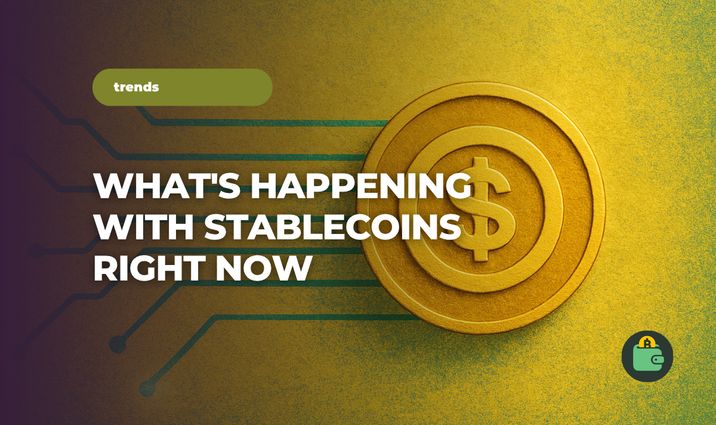Why You Don't Need to Buy Stablecoins Right Now

A few weeks ago, Donald Trump signed the GENIUS and CLARITY Acts, regulating stablecoins. These landmark acts introduce licensing of issuers of “payable stablecoins” and strict oversight: only “authorized issuers” (specially licensed banks, trusts, or companies that meet specified criteria) will be able to issue stablecoins.
The market reacted rapidly: the crypto market capitalization surged, exceeding $4 trillion for the first time in history, largely due to the positive performance of Ethereum (up ~20% to $3,500) and Bitcoin (up to ~$123,000, then around $117,000).
Coinbase shares rose by as much as 16–17% to around $297.4 on expectations of expanded licensed operations involving USDC, a joint project between Coinbase and Circle. At the same time, Visa and Mastercard shares showed relative declines as the market refocused on federally licensed stablecoin-based payment solutions.
Whether does it mean you should invest in stablecoins and affiliated companies or projects with it? We don't think so, and that's why.
Does that mean you should invest in stablecoins and affiliated companies or projects related to them?
We don't think so. Everything has two sides: a positive one and a negative one. In this article, we’ll try to look at both.
Disclaimer: Crypto is a high-risk asset class. This article is provided for informational purposes and does not constitute investment advice. You could lose all of your capital.
❌ The Risk of a New Economic Crisis
Some experts warn of potential systemic risks, comparing the new schemes to the deregulatory policies and the 2008 crisis, particularly because of the construction of “financial cycles” backed by Treasuries.
In addition, analysts are divided: supporters (Coinbase, Cato Institute, Moody's) believe the law creates legal clarity and promotes industry growth, while critics fear increased oversight, registration, and restriction of competition.
“This is being framed as a crypto bill, and in some ways it is. But it has not reached most people’s radar that its biggest beneficiary is likely to be large tech platforms,” says Hilary Allen, a professor at American University Washington College of Law and a vocal crypto skeptic in D.C.
We’ll take the liberty of quoting Allen directly from the TIME article — it’s a really good example.
Allen lays out a hypothetical scenario in which Amazon issues stablecoins. They could then conceivably scale its usage among Amazon employees and users, Whole Foods shoppers, and Washington Post subscribers, to the point that many people start relying on stablecoins as opposed to bank accounts. “That’s really bad news, because banks take the money deposited with them and loan them out into the economy, while stablecoin reserves just sit there,” Allen says. “So money that had been used productively in our economy is now just sitting with Amazon.”
❌ Limited Investor Protection and Risk of Fraud
Compared to similar bank products, stablecoins may not offer the same protections. Investopedia analysts emphasize that funds are not insured, payments are irreversible, and the chances of recovering money in case of scams or fraud are limited.
Furthermore, technical errors and wallet incompatibilities can lead to irreversible loss of funds.
❌ Lack of Anonymity and Privacy
Fisher Investments and others emphasize that stablecoins are not investment assets but are designed for payments. The GENIUS Act does not change the nature of stablecoins — they remain speculative and volatile, despite the new reserve requirements.
Moreover, U.S.-issued stablecoins are fully transparent. This means that U.S. financial and tax authorities have access to your transaction data.
✅ Regulatory Clarity Creates First-Mover Advantage
The passage of the GENIUS Act removes legal uncertainty for issuers of USDC, USDT, and other compliant stablecoins. According to Investopedia, financiers and investors expect companies already compliant with the federal standard to gain significant first-mover advantage in the market. Among them are Circle and Coinbase, which can scale their businesses more quickly and close large deals thanks to a legalized issuance platform.
✅ Circle IPO Confirms Investor Confidence in the Stablecoin Business
Circle’s June 2025 IPO was one of the most successful in recent U.S. history, with shares rising 168% on the NYSE immediately after the debut. The company’s market capitalization exceeded $22 billion, and analysts saw the success as a signal of broad institutional support and growing confidence in the future of USDC-based stablecoins.
✅ Institutional Adoption and Infrastructure Scaling
Major players such as Goldman Sachs, BNY Mellon, JPMorgan, Citi, and Bank of America are already actively developing infrastructure to tokenize the money markets and integrate stablecoins for corporate clients. Investors see the potential to expand the market, reduce settlement costs, and improve liquidity through new payment rails.
The Bottom Line
If you are an investor with a moderate risk appetite and a long horizon, getting involved in the industry now — amid regulation and growing institutional demand — could bring significant returns. However, it is important to choose the most stable and licensed players, such as Circle, rather than riskier structures like Tether.
If you are a conservative investor, you should wait a bit: the market is going through a transitional phase, and we will see in 6–12 months which companies and stablecoins adapt best.